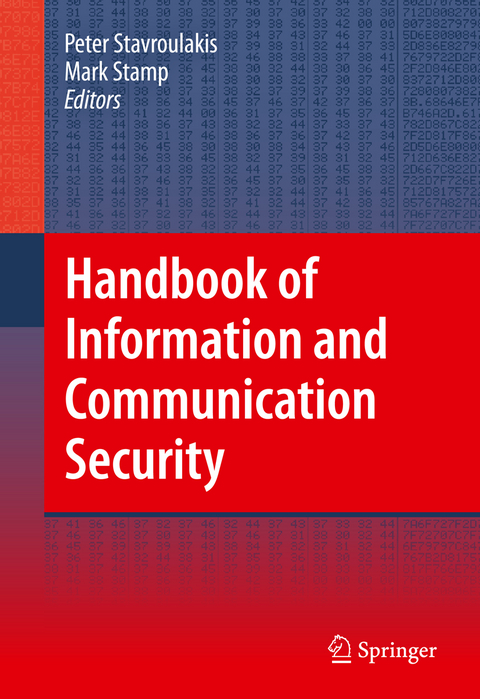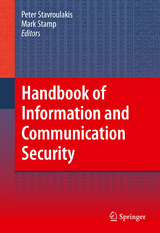Handbook of Information and Communication Security
Springer Berlin (Verlag)
978-3-642-04116-7 (ISBN)
Part A Fundamentals and CryptographyA Framework for System Security .- Public-Key Cryptography.- Elliptic Curve Cryptography.- Cryptographic Hash Functions.- Block Cipher Cryptanalysis.- Chaos-Based Information Security.- Bio-Cryptography.- Quantum Cryptography.-Part B Intrusion Detection and Access ControlIntrusion Detection and Prevention Systems.- Intrusion Detection Systems.- Intranet Security via Firewalls.- Distributed Port Scan Detection.- Host-Based Anomaly Intrusion Detection.- Security in Relational Databases.- Anti-Bot Strategies Based on Human Interactive Proofs.- Access and Usage Control in GRID Systems.- Secure Human Identification.-Part C NetworkingPeer-to-Peer Botnets.- Security of Service Networks.- SCADA Security.- Mobile Ad-Hoc Network Routing.- Security Approach for Ad-Hoc Networks.- Phishing: Attacks and Countermeasures´.-Part D Optical NetworkingChaos-Based Secure Optical Communications.- Chaos Applications in Optical Communications.-Part E Wireless NetworkingSecurity in Wireless Sensor Networks.- Secure routing in Wireless Sensor Networks.- Security Via Surveillance and Monitoring.- Security and QoS in Wireless Networks.-Part F SoftwareLow-Level Software Security by Example.- Software Reverse Engineering.- Trusted Computing.- Security via Trusted Communications.- Viruses and Malware.- Designing a Secure Programming Language.-Part G Forensics and Legal IssuesFundamentals of Digital Forensic Evidence.- Multimedia Forensics for Detecting Forgeries.- Technological and Legal Aspects of CISSubject Index
Aus den Rezensionen: "... Besonderes Augenmerk gilt dabei dem Wechselspiel zwischen Kommunikation und dem Bereich der Informationssicherheit. ... herausgegriffene Themen illustrieren die Relevanz des Buchs. ... Verschiedene HIPs werden vorgestellt und verglichen Weitere Beitrage befassen sich mit Phishing Attacken bzw mit Authentifikationen mittels biometrischer Methoden. ... Die Beitrage sind theoretisch fundiert und oft praxisbezogen. ... Das Buch eignet sich deshalb gut als Einstiegslektüre für Studierende oder für Informatiker, die sich nur am Rande für die Sicherheitsthematik interessieren. Für Experten ist das Buch eine wertvolle, vielseitige Inspirationsquelle." (in: Bulletin electrosuisse, 2/July/2010, Issue 7, S. 121)
Aus den Rezensionen:
“... Besonderes Augenmerk gilt dabei dem Wechselspiel zwischen Kommunikation und dem Bereich der Informationssicherheit. ... herausgegriffene Themen illustrieren die Relevanz des Buchs. … Verschiedene HIPs werden vorgestellt und verglichen Weitere Beitrage befassen sich mit Phishing Attacken bzw mit Authentifikationen mittels biometrischer Methoden. ... Die Beitrage sind theoretisch fundiert und oft praxisbezogen. … Das Buch eignet sich deshalb gut als Einstiegslektüre für Studierende oder für Informatiker, die sich nur am Rande für die Sicherheitsthematik interessieren. Für Experten ist das Buch eine wertvolle, vielseitige Inspirationsquelle.“ (in: Bulletin electrosuisse, 2/July/2010, Issue 7, S. 121)
| Erscheint lt. Verlag | 19.2.2010 |
|---|---|
| Zusatzinfo | XVI, 867 p. |
| Verlagsort | Berlin |
| Sprache | englisch |
| Maße | 155 x 235 mm |
| Themenwelt | Technik ► Elektrotechnik / Energietechnik |
| Technik ► Nachrichtentechnik | |
| Schlagworte | ACCESS • Communication • Database • Firewall • Hardcover, Softcover / Technik/Elektronik, Elektrotechnik, Nachrichtentechnik • Information • Intrusion Detection • Monitoring • Quality of Service • Quality of Service (QoS) • Relational Database • Routing • security • wireless sensor networks |
| ISBN-10 | 3-642-04116-7 / 3642041167 |
| ISBN-13 | 978-3-642-04116-7 / 9783642041167 |
| Zustand | Neuware |
| Haben Sie eine Frage zum Produkt? |
aus dem Bereich




